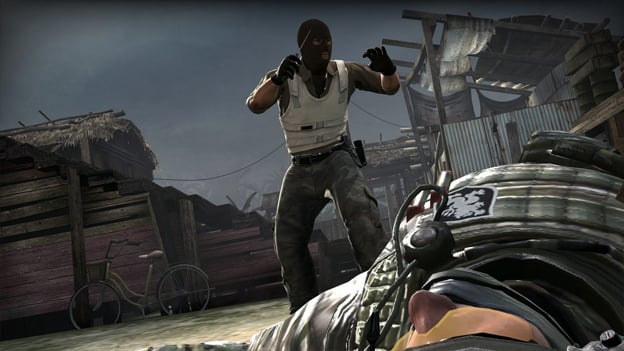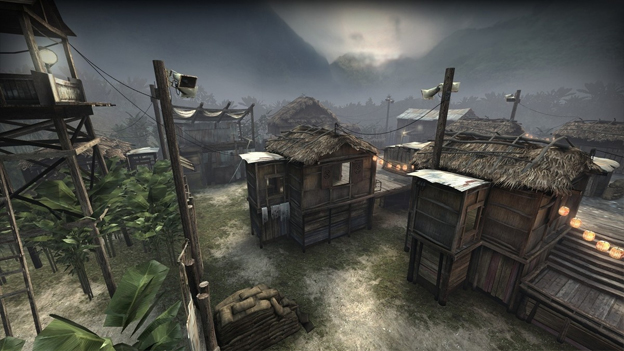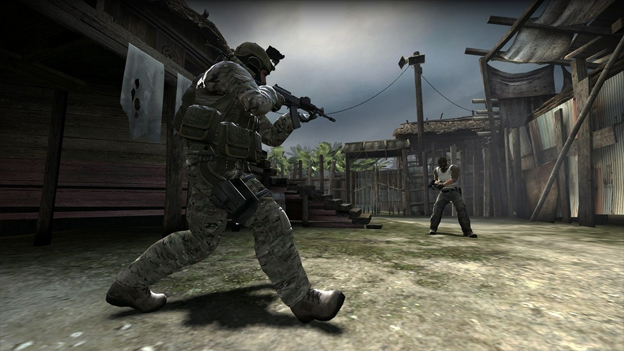Global Offensive And Neil Diamond Have A Lot In Common
To the layperson, it may seem a little strange that Valve would dump a seemingly endless stream of time and money into Counter-Strike: Global Offensive. After all, CS:GO is essentially just a graphical update of a twelve-year-old mod that’s already been rereleased twice. But if you were to mention this to any seasoned Counter-Strike player, you would quickly have one fewer friend on Facebook.
I mean, most games spawn sequels and spinoffs, but not Counter-Strike. CS just keeps getting updated and remixed, which makes sense when you consider its relentless popularity. As I write this, there are over 50,000 people simultaneously playing Counter-Strike in one of its many forms, so why would Valve force a sequel onto a community that has essentially been playing the same game for twelve years straight?

“Counter-Strike took the gaming industry by surprise when the unlikely MOD became the most played online PC action game in the world almost immediately after its release in August 1999,” says Doug Lombardi, the Director of Marketing at Valve. “For the past 12 years, it has continued to be one of the most-played games in the world, headline competitive gaming tournaments and selling over 25 million units worldwide across the franchise. CS: GO promises to expand on CS’ award-winning gameplay and deliver it to gamers on the PC as well as the next gen consoles and the Mac.”
But expanding on CS’ award-winning gameplay might be a bit tougher than Valve thinks. The CS community can be a difficult egg to crack.
See, when Valve released Counter-Strike: Source in 2004, it was intended to be an upgrade for a prominent, yet aging, title. The problem is that CS players didn’t really buy into the game like Valve was hoping, so when it was released, the community was immediately split in half. CS purists refused to accept Source’s new physics, gunplay, and map design, so they hung on to 1.6 while half of the community migrated to the newer platform. This might have been perfectly acceptable for most franchises, but, at the time, Counter-Strike was the gaming world’s only real hope for a professional-level electronic sport. So with the CS community fragmented, the gaming world’s dream of a truly professional league started slowly disappearing.

This little history lesson is the back-story to Doug Lombardi’s comments. The folks at Valve are crossing their fingers that Global Offensive will effectively put Humpty Dumpty back together again and simultaneously lay the foundation for newly minted pro league. But all of this forces us to ask a very important question: can CS really thrive in today’s market?
See, when Global Offensive was originally revealed, Valve made sure to mention that professional CS:1.6 and CS:S players had been secretly meeting with the developer to offer suggestions and help tweak the gameplay. On the surface, it really did seem like Valve was taking great pains to create a game that adopted all of the successful parts of 1.6 and marry them with the perks of CS:S, which could, in theory, sew the community back together again.
But when the Beta testing began in November, it quickly became obvious that CS: GO was more closely related to CS:S than it was to 1.6. Unfortunately, this could mean that Valve may have erected yet another community-splitting wall.

Player movement, for instance, has the same silky-smooth rigidity that Source players are undoubtedly used to (though the strafe speed has been inexplicably increased); it’s a holdover from when map designers had fewer terrain options. The movement felt natural in Source, because the maps had their roots in 1.6, all of which were basically made up of entirely flat surfaces. But when compared to the Call of Duty and Battlefield franchises, it feels like your CS avatar is an avid rollerblader.
Also, the ability to fire through an object was one of the defining features of 1.6, but surface penetration has grown increasingly more difficult with every passing incarnation. Obviously, the changes are the result of an effort to increase realism, but in this case, realism comes at the expense of tactics, which is one of the reasons why 1.6 refuses to die.
The controls in Global Offensive are, well, exactly the same as every other CS title. If you’ve played a PC FPS in the last twelve years, you’re familiar with the WASD setup. However, there is a small in-game tutorial for the genuine newbies out there. But if you really need to use this, your grandkids would probably make better use of your gaming rig than you ever would.
Even though the similarities between 1.6, CS:S, and Global Offensive are numerous, Valve didn’t leave everything the same. GO has a few new modes (which admittedly mirror several popular 1.6 mods), a new buy menu, and a couple of new weapons (including a Molotov cocktail). They’ve even added zombie mod support to the retail release, because what FPS is complete without zombies these days? However, at its core, it’s the same game that changed the entire industry so many years ago. The first time you hear the familiar sound of an AK-47’s fire, it’ll undoubtedly feel as comfortable as an old pair of pajama pants.
Actually, part of what made CS brilliant was the weaponry, and Counter-Strike’s gunplay is as intricate as ever. Spraying your weapon in the enemy’s general direction isn’t going to net you any kills. You’re going to have to pay attention to how your gun is behaving and make adjustments every time you pull the trigger. The separation between newbie and professional is far greater in the CS community than it is in almost every other game (shut up, StarCraft players). Call of Duty enthusiasts are probably going to feel pretty manhandled the first time they log in. My advice: just be prepared to die a lot. Everyone else has been playing this game for a decade.
Valve has obviously spent a good deal of time refining Global Offensive, but some of their decisions are a bit questionable. At its core, Counter-Strike has always been about the map design. Modern Warfare has its vertical maps and fast-paced gameplay, Battlefield has wide-open arenas and vehicle battles, but Counter-Strike is all about the chokepoints, methodical teamwork, and gunplay. This is why it was so quickly adopted by pro gamers.
In CS, teams that are able to hold down the chokepoints win the round, whereas CoD relies heavily on killstreak rewards and ignores chokepoints altogether. So, you can understand why I’m worried about several of the tweaks that the CS:GO team has been making to the maps. The routes in de_inferno, for instance, have been heavily reworked. The sight lines on de_dust and de_dust2 have been drastically changed, and de_nuke has had one route entirely removed. All of these maps had their place in league play, which means that these new tweaks could cause major balance issues once pro competition starts up.

Here’s the deal: CS: Go has obviously been tailored to competitive play. Sure, there’s a casual mode, but that’s not the mode that Valve has been incessantly tweaking and retooling based on user feedback. Between the intricate gunplay and the chokepoint-oriented map design, it’s really not meant for free-for-all play. And, even though Global Offensive has a lot of other incredibly intelligent upgrades, I’m worried that the newly redesigned maps are oriented toward casual players, even though the rest of the game isn’t.
However, everything that I’ve written up until now may mean nothing in six months. Valve is taking a classical development approach to CS: GO, which means that work has really only just begun on the title. This game is going to be patched and repatched until the company decides to build another version of CS. Plus, they’re genuinely trying to listen to what players actually want from the game this time around.
Last month, Forbes said that Counter-Strike: GO was a “huge leap for the top-selling FPS series.” This couldn’t be further from the truth. Global Offensive is a slightly upgraded version of CS:S with a few new tweaks and toys. But perhaps CS doesn’t actually need much of an upgrade. I mean, when a game is perfect enough to change the industry and garner a decade’s worth of nonstop playtime, perhaps the recipe is just right and only needs to be tweaked for every new generation of gamer.
But part of me thinks we’re acting a bit like my dad.
Whenever Neil Diamond releases a new record, my dad always buys a copy. It’s not that Neil’s music is new and exciting; in fact, it’s just the opposite. Diamond’s music is new enough to be interesting, but familiar enough to stay within his comfort zone. As Neil Diamond grows older, his audience grows smaller and smaller. He’ll never have another big hit, because the music industry has moved on without him. The same people who were buying his records thirty years ago are the ones who are buying them now.
Is this what’s happening with Counter-Strike? Every time I launched CS:GO this week, I couldn’t help buy feel like it was a step backwards in my gaming evolution. It’s new, but it’s entirely familiar as well. The learning curve is shallow and I know I’m probably going to enjoy it before I even start.
The question itself makes me feel like an old man and part of me feels obligated to answer, but the other parts just want to go play dust_2 for the twelfth year in a row.
I’ll cover catwalk.
RATING OUT OF 5 RATING DESCRIPTION 3.5 Graphics
Very solid upgrade from Source. But nothing special. 4.5 Control
Instantly Familiar. 4.0 Music / Sound FX / Voice Acting
Pays homage to the original sounds without sacrificing quality. 4.0 Play Value
For only $15, it’s definitely worth picking up, but it may not have the same kind of replay value as its predecessors. 4.0 Overall Rating – Great
Not an average. See Rating legend below for a final score breakdown.
| Review Rating Legend | |||
|---|---|---|---|
| 0.1 – 1.9 = Avoid | 2.5 – 2.9 = Average | 3.5 – 3.9 = Good | 4.5 – 4.9 = Must Buy |
| 2.0 – 2.4 = Poor | 3.0 – 3.4 = Fair | 4.0 – 4.4 = Great | 5.0 = The Best |
Game Features:
